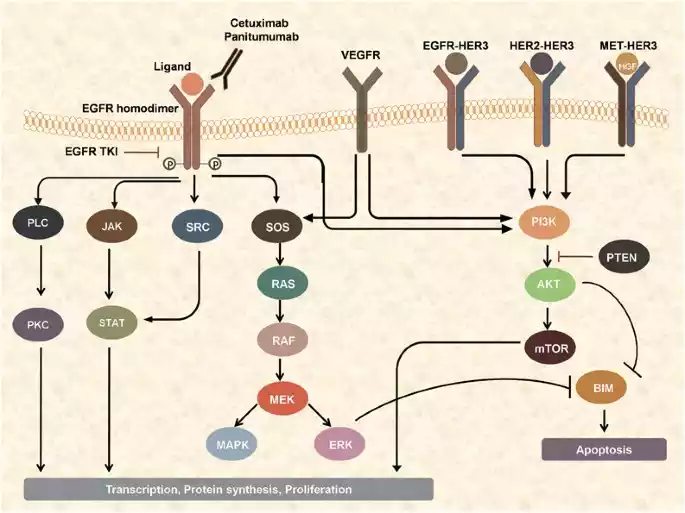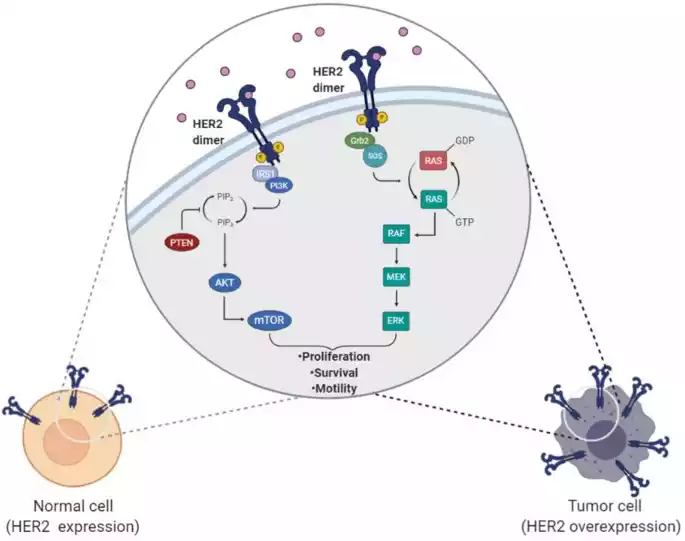Introduction to EGFR and HER2
EGFR (Epidermal Growth Factor Receptor) and HER2 (Human Epidermal Growth Factor Receptor 2) are two critical receptors in the world of cancer research and treatment. These receptors, found on the surface of cells, play essential roles in regulating cell growth and division. However, when they malfunction, they can lead to cancer development and progression.
EGFR is a receptor that, when functioning correctly, helps regulate tissue growth and repair. It’s often associated with lung cancer and other malignancies, where it has become a target for innovative therapies.
HER2, part of the Human Epidermal Growth Factor Receptor family, is implicated in the aggressive nature of certain breast cancers. Understanding these receptors and their differences is vital for effective cancer diagnosis and treatment. In this brief exploration, we’ll touch on their basic functions, their role in cancer, and the importance of targeted therapies designed to combat cancers driven by EGFR and HER2.
EGFR (Epidermal Growth Factor Receptor)
EGFR, short for Epidermal Growth Factor Receptor, is a pivotal cell surface receptor that belongs to the family of receptor tyrosine kinases. It plays a crucial role in regulating cell growth, proliferation, and differentiation.
EGFR is a transmembrane protein, meaning it spans the cell membrane, with its extracellular domain exposed to the cell’s external environment and its intracellular domain positioned inside the cell.

Key Points:
- Normal Function: In normal, healthy cells, EGFR is responsible for responding to signals from growth factors like epidermal growth factor (EGF). When these growth factors bind to EGFR, it triggers a cascade of molecular events inside the cell, leading to cell growth and division as part of normal tissue development and repair.
- Aberrant Signaling: Mutations or overexpression of EGFR can lead to abnormal signaling pathways, resulting in uncontrolled cell growth. This can contribute to the development and progression of various types of cancer, including lung, colon, and head and neck cancers.
- Cancer Association: EGFR is particularly well-known for its role in lung cancer. EGFR mutations, for example, are found in a significant portion of non-small cell lung cancers (NSCLC). These mutations can drive tumor growth, making EGFR a target for specific cancer therapies known as EGFR inhibitors.
- Diagnosis: To determine the presence of EGFR mutations or overexpression, various diagnostic tests are employed, including Polymerase Chain Reaction (PCR), Fluorescence In Situ Hybridization (FISH), and Immunohistochemistry (IHC).
- Targeted Therapies: The discovery of EGFR mutations in certain cancers has led to the development of targeted therapies like EGFR tyrosine kinase inhibitors (TKIs). These drugs specifically inhibit the aberrant EGFR signaling seen in cancer cells, offering more effective and less toxic treatment options for patients.
Understanding EGFR’s normal functions and its role in cancer is fundamental for both cancer research and the development of personalized treatment strategies. Targeted therapies aimed at EGFR have significantly improved outcomes for patients with EGFR-driven cancers, highlighting the importance of this receptor in the world of oncology.
HER2 (Human Epidermal Growth Factor Receptor 2)
HER2, short for Human Epidermal Growth Factor Receptor 2, is a critical cell surface receptor that belongs to the Human Epidermal Growth Factor Receptor family, commonly referred to as the HER family.
This receptor plays a vital role in regulating cell growth and proliferation. HER2, like other HER family members, is a transmembrane protein, meaning it spans the cell membrane.

Key Points:
- Normal Function: In normal, healthy cells, HER2 plays a role in regulating cell growth and division in response to specific growth factors. It often forms partnerships with other HER family members, such as HER1 (EGFR), HER3, and HER4, to initiate signaling cascades that control various cellular processes.
- Amplification and Overexpression: In some cancer cases, HER2 is overexpressed or amplified, leading to an excessive number of HER2 receptors on the cell surface. This amplification or overexpression can drive uncontrolled cell growth and is often associated with more aggressive cancer behavior.
- Cancer Association: HER2 overexpression is most famously associated with breast cancer. Tumors that have an excess of HER2 receptors on their surface are referred to as “HER2-positive” breast cancers. These cancers tend to be more aggressive and have a higher risk of recurrence.
- Targeted Therapies: The discovery of HER2’s role in cancer has led to the development of targeted therapies specifically designed to inhibit HER2 signaling. Drugs like Herceptin (trastuzumab) and pertuzumab have revolutionized the treatment of HER2-positive breast cancer, significantly improving outcomes for patients.
- Diagnosis: To determine HER2 status in breast cancer, tests like Immunohistochemistry (IHC) and Fluorescence In Situ Hybridization (FISH) are commonly used. These tests assess the level of HER2 protein expression and gene amplification, respectively.
Understanding HER2’s role in normal cellular processes and its implications in cancer is essential in diagnosing and treating HER2-driven malignancies. Targeted therapies directed at HER2 have significantly improved the prognosis and treatment options for patients with HER2-positive breast cancer and have opened doors for similar approaches in other HER2-associated cancers.
egfr-vs-her2 comparison chart
Here is a comparison chart that highlights key distinctions between EGFR (Epidermal Growth Factor Receptor) and HER2 (Human Epidermal Growth Factor Receptor 2):
| Aspect | EGFR (Epidermal Growth Factor Receptor) | HER2 (Human Epidermal Growth Factor Receptor 2) |
|---|---|---|
| Molecular Classification | Receptor Tyrosine Kinase | Member of the HER Family |
| Normal Function | Regulates cell growth, repair, and development in response to ligands like EGF | Regulates cell growth and proliferation in coordination with other HER family members |
| Aberrant Signaling in Cancer | Mutations or overexpression can lead to uncontrolled cell growth and cancer development | Overexpression or gene amplification can drive aggressive cancer behavior |
| Associated Cancers | Commonly associated with lung cancer (EGFR mutations), but also found in other malignancies | Most famously associated with HER2-positive breast cancer, but also observed in other cancer types |
| Cancer Target | The target for therapies like EGFR inhibitors (e.g., Gefitinib, Erlotinib) | Target for HER2 inhibitors (e.g., Trastuzumab, Pertuzumab) |
| Ligand Dependency | Generally requires ligand binding for activation (ligand-dependent) | Can activate signaling pathways even without ligand binding (ligand-independent) |
| Diagnostic Methods | Various tests like Polymerase Chain Reaction (PCR), Fluorescence In Situ Hybridization (FISH), and Immunohistochemistry (IHC) | Immunohistochemistry (IHC) and Fluorescence In Situ Hybridization (FISH) are commonly used to determine HER2 status in breast cancer |
| Treatment Implications | Targeted therapies like EGFR tyrosine kinase inhibitors (TKIs) are effective against EGFR-driven cancers | Targeted therapies like HER2 inhibitors have greatly improved outcomes for HER2-positive cancer patients |
| Clinical Significance | Personalized medicine and precision oncology strategies often involve targeting EGFR or HER2 based on biomarker status | Identifying HER2 status is crucial in determining treatment strategies for breast cancer patients |
| Research and Development | Ongoing research into EGFR and EGFR inhibitor resistance mechanisms | Continued investigation into HER2 biology and the development of new HER2-targeted therapies |
| Impact on Survival Rates | Targeted therapies have significantly improved survival rates for EGFR-driven and HER2-positive cancers | Improved prognosis and treatment options for patients with EGFR or HER2-associated cancers |
This comparison chart provides a quick overview of the distinctions between EGFR and HER2, highlighting their molecular characteristics, roles in cancer, diagnostic methods, and treatment implications. Understanding these differences is essential in the context of cancer diagnosis and treatment planning.
Treatment Implications
EGFR and HER2 have profound implications for cancer treatment:
- EGFR: Targeted therapies like EGFR inhibitors (e.g., Gefitinib, Erlotinib) have revolutionized the treatment of EGFR-driven cancers, particularly lung cancer. Identifying EGFR mutations or overexpression guides the use of these effective therapies.
- HER2: HER2 inhibitors (e.g., Trastuzumab, Pertuzumab) have significantly improved outcomes for HER2-positive breast cancer patients. Determining HER2 status through tests like IHC and FISH is critical for tailoring treatment strategies.
In both cases, these targeted therapies have led to improved survival rates and exemplify the importance of precision medicine in cancer care.
Conclusion
EGFR and HER2 are pivotal receptors with significant implications for cancer diagnosis and treatment. Understanding their roles in normal cell function and how they can go awry in cancer is essential. Targeted therapies designed to combat EGFR or HER2-driven cancers have transformed patient outcomes, emphasizing the importance of personalized treatment strategies in the fight against cancer.
